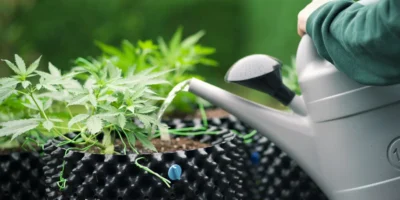cannabis water

Cultivation – Essential Guidelines for Indoor & Outdoor Gro✅ The Role of Water in Cannabis ws
Water is one of the most crucial and overlooked elements in cannabis cultivation. Whether you grow outdoors under the sun or in a controlled indoor environment, proper water management directly impacts plant health, nutrient uptake, and final yield.
In this article, we’ll explore how water quality, quantity, timing, and delivery methods affect cannabis at every stage of growth.
- Water Quality Matters
Poor water can lead to toxic buildup, nutrient lockout, or pH imbalance. Key factors to monitor:
- pH level:
- Ideal range: 6.0–6.5 (soil), 5.8–6.2 (hydro/coco)
- EC/TDS (Electrical Conductivity / Total Dissolved Solids):
- Indicates nutrient concentration
- Too high = salt buildup, too low = deficiency risk
- Contaminants:
- Avoid water with chlorine, heavy metals, or pathogens
- Use filtered or RO (reverse osmosis) water if needed
- How Much to Water (And When)
Overwatering and underwatering are both harmful. General rules:
- Soil (outdoor & indoor):
- Water only when the top 2–3 cm feels dry
- Use pots with drainage holes
- Coco/hydroponics:
- Water more frequently, often daily
- Monitor runoff EC to avoid salt buildup
For outdoor plants, frequency depends on:
- Weather (heat & wind increase demand)

- Soil structure (sandy soil dries faster)
- Best Time to Water
- Outdoor grows:
Early morning or late afternoon to avoid midday evaporation - Indoor grows:
During “lights on” cycle to match transpiration and prevent mold
- Watering Techniques
- Hand watering:
Simple and effective for small-scale grows - Drip irrigation:
Great for automation and water conservation - Top feeding vs bottom feeding:
- Top feeding promotes microbial activity in soil
- Bottom feeding can help with seedling stability
- Signs of Watering Problems
| Issue | Symptoms |
| Overwatering | Droopy, yellow leaves, root rot risk |
| Underwatering | Wilting, dry soil, slow growth |
| High EC buildup | Leaf burn, tip browning |
| Low pH | Nutrient lockout, twisted new leaves |
- Final Tips
- Always check the pH of your water before feeding
- Avoid watering schedules – let the plant and soil tell you when it needs water
- Use mulch outdoors to retain soil moisture
- Indoor: watch humidity – excess water = higher RH = mold risk
